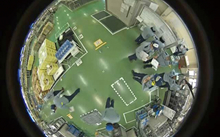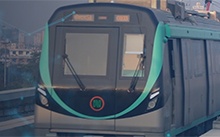Technologies such as IoTand AI, which have a tremendous impact on our society, are evolving. In 2016, Hitachi joined with the University of Tokyo to establish the "Hitachi and the University of Tokyo Joint Research Laboratory" ("H-UTokyoLab"), a space for the pursuit of joint research into a "super smart society." Combining Hitachi's extensive expertise in infrastructure technologies and in IT with the University of Tokyo's cutting-edge research, this laboratory hosts research into building a society where solutions to social issues and enhanced QoLco-exist.
As society comes to enjoy unprecedented convenience due to the rapid progress of IT, it is also being challenged by long-standing social issues in Japan, including declining birthrate and aging society, concentration of populations in cities and regional revitalization, energy, and the environment.
In 2016, the Japanese government announced its Super Smart Society (Society 5.0)initiative. Looking to what comes after the current Information Society (Society 4.0) initiative, Society 5.0 represents a vision for the future society to which Japan should aspire. In other words, Society 5.0 leverages IoT, AI, big data, and other high-tech innovations so as to promote comfortable, vital, and high-quality lifestyles while seeking a balance between economic development and the finding of solutions to social issues.
The attainment of this goal calls for not only a company's development and technological capabilities, but also the merging of knowledge from diverse fields.
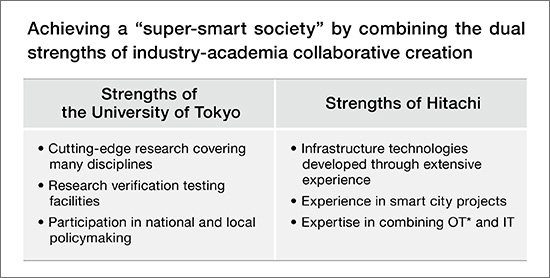
*OT: Operational Technology
Since its founding in 1877, the University of Tokyo has developed into a place where various Eastern and Western ideas and cultures are united into new areas of scholarship. In the carrying on of this tradition, the University of Tokyo takes a global perspective in integrating diverse knowledge and contributing to interdisciplinary research and to policy formation.
Making Society 5.0 a reality requires efforts that span multiple fields. The key to enabling such efforts is the fusion of Hitachi's infrastructure technology and IT, developed over the years in the execution of its Social Innovation Business, with the University of Tokyo's various types of cutting-edge knowledge. Against this backdrop, Hitachi and the University of Tokyo have established the H-UTokyoLab as a space for joint research and have launched Habitat Innovation, a project based on collaborative creation for the purpose of research aimed at achieving Society 5.0.
Why industry-academia ”collaborative creation” instead of industry-academia ”collaboration”? The reasons lie in systematic differences and in the themes being handled. In general, conventional industry-academia collaboration involves joint research by a university research laboratory and the department of a company. There is also a tendency for research themes to be subdivided into specialized areas. However, in the case of industry-academia collaborative creation, universities and companies cooperate with each other as large-scale organizations. In addition, in a departure from relying on a single research lab, people from different fields bring together their knowledge and hold discussions. This makes it possible to handle major themes, such as social issues whose strategies require multi-faceted considerations. Of particular note in this respect is how the H-UTokyoLab initiatives are contributing to policymaking at national and local levels, as is needed for the social implementation of research outcomes.
In the pursuit of multi-thematic research, this project brings into synergy the resources of the University of Tokyo including knowledge in city planning, traffic engineering, building environment, and other academic studies concerning urban issues and residences, along with the deep insights from experts in such academic fields as social sciences and humanities. Paired with these is Hitachi’s strengths in the infrastructure technologies and IT needed for social implementation.
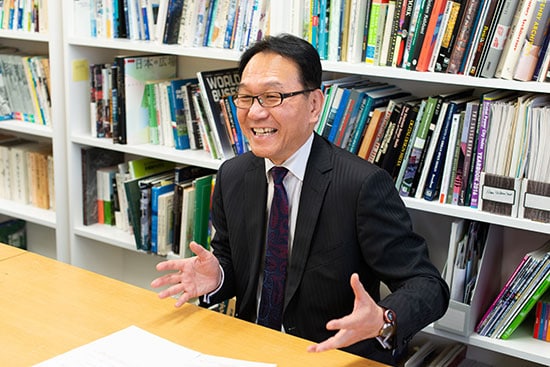
Atsushi Deguchi, professor at the Graduate School of Frontier Sciences at the University of Tokyo (head of the H-UTokyoLab)
According to Atsushi Deguchi, head of the H-UTokyoLab and professor at the Graduate School of Frontier Sciences at the University of Tokyo: "Not stopping at data management in a specific field, Habitat Innovation involves exploring the creation of advanced services, for city planning and urban development, that link data across different fields. An example of this would be combining real estate, transit, and urban planning data instead of just analyzing transit data. By making a careful study of when and how regional residents move, we can improve transit convenience and alleviate traffic congestion, which will also raise the value of real estate."
Professor Deguchialso says that although several cases of city planning that use data are known to exist overseas, there is a definitive difference.
As he explains: "This project is led not by the government or by industry players, but by city residents. Profits and knowledge are not monopolized by an administrative agency or a single company but are given back to the regional community. Moreover, in contrast with top-down requests, regional participants are the data providers and data readers, and they work with the regional community toward urban development."
Verification testing of one of this initiative's research themes, "data-driven city planning," was started in Matsuyama City, Ehime Prefecture. With the cooperation of city residents, people-flow analysis technology was used to learn about movement behavior in the city. This was combined with data from different fields, including transit, purchasing behavior, and others, for visualization using Cyber-PoC, a service business simulator developed by Hitachi. Analyzing and studying city resident behavioral data from multiple angles in a digital space and making use of the results in city planning made it possible to build parks and childcare centers where residents need them and to hold community events matched with community needs. In this way, city residents could see how their voices were being reflected in urban development, creating a cycle of further active participation in such development.
The provision of the behavioral data required to drive this cycle is predicated on the understanding and active participation of city residents. In the handling of data, in addition to maintaining anonymity and protecting personal information, research into the state of ideas generally accepted by society is needed. To assist in this, experts in psychology, philosophy, and other humanities from the University of Tokyo have been brought in and discussions began.
According to Professor Deguchi: "Smart city projects in Japan have only just partly begun and are still very much in the social testing phase. In order for the merits of a data-driven society to become a common aspect of cities nationwide in Japan, multifarious data must by analyzed, a model must be designed that can produce mutual advantages across different fields, and hypothesis verification must be repeated.“
While the project is currently still in the verification phase, provided research continues to go forward, and with the Matsuyama City initiative serving as a reference, the results are expected to be applied to the city centers of central cities having populations in the several hundreds of thousands and relatively similar conditions in terms of urban environment, industrial structure, and other such factors. Large cities are typically the stage for overseas smart cities, thus a system for a regional city such as Matsuyama City is rare. By sharing its example not only domestically, but also with cities overseas, the potential exists for the knowledge obtained by the city to serve as a reference for urban development worldwide.
Habitat Innovation deals with a number of themes in addition to "data-driven city planning," all of which are directly connected to the major social issues that Japan faces today. As indicated by the name "Habitat Innovation" (with "Habitat" referring to a "residence") and with respect to each theme, creating a system whose implementation is led by city residents will make it possible to achieve a sustainable society where industry, academia, government, and citizens can cooperate and progress together.
Looking into the near future, Professor Deguchisays: "Having been called the advanced country with challenges, Japan has many issues that cannot be overlooked. But we see this as an advantage. This is because the process of improving these issues via Habitat Innovation enables us to pioneer a model for finding solutions to the issues at hand."
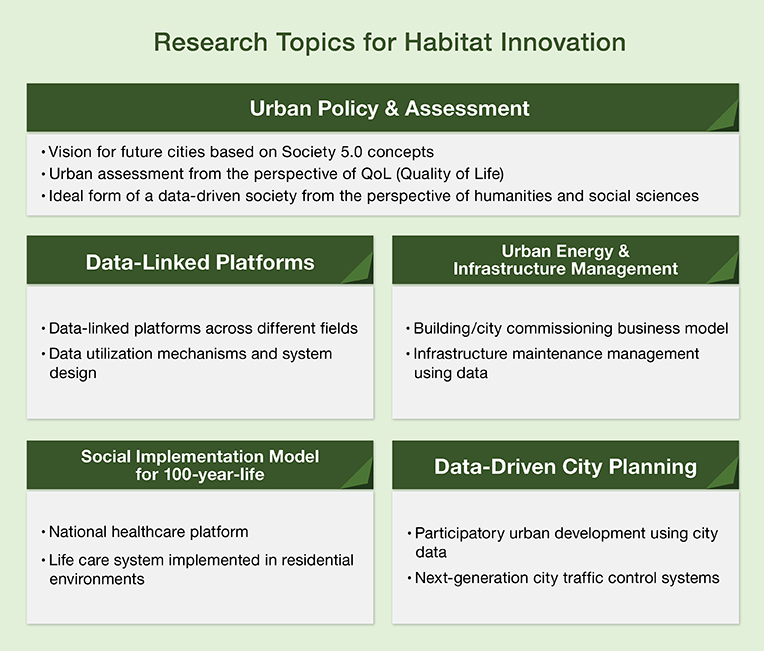
Release Date: March 2019
Solutions By: Research & Development Group, Hitachi, Ltd.
